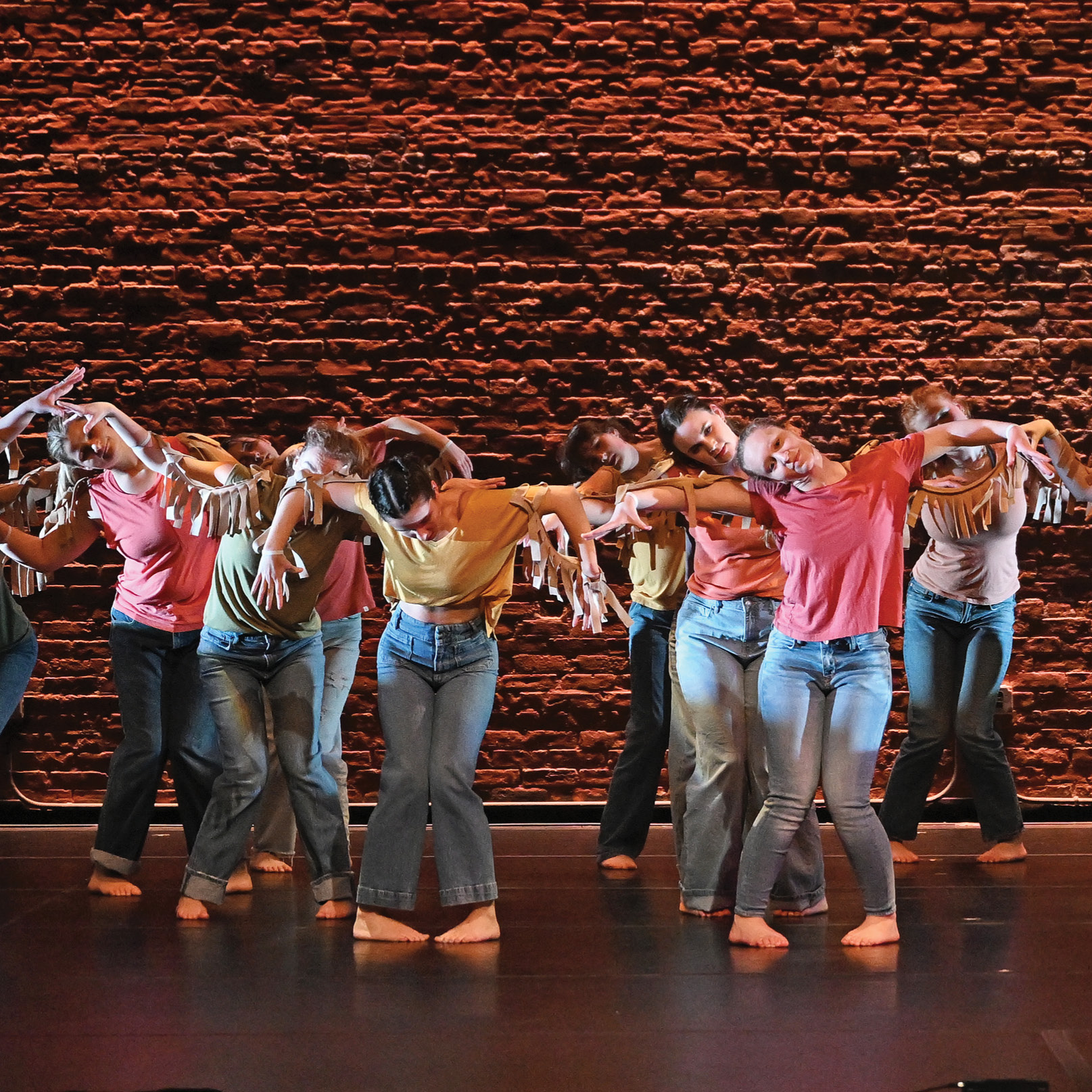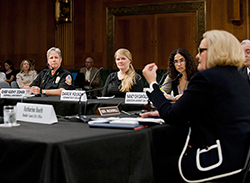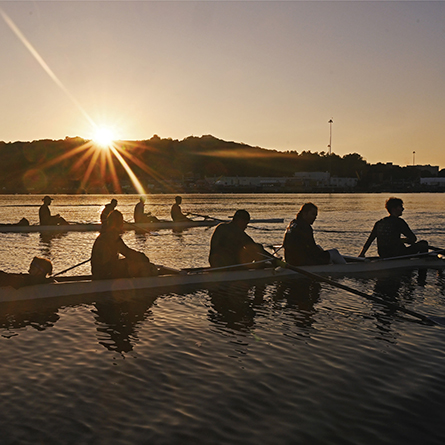
Connecting the dots

On most college campuses today, sexual assault isn’t discussed over a cup of coffee in the dining hall. It isn’t talked about on the playing fields. It isn’t something most students feel comfortable conversing about with their friends, their professors, their administrators.
Connecticut College is different.
It’s just the second day of classes in the fall semester, and a group of 10 students have joined President Katherine Bergeron, several staff members and representatives from the community for an open discussion with U.S. Sen. Richard Blumenthal about sexual assault. Blumenthal is on a nine-campus listening tour, and the students are eager to talk.
They explain to Connecticut’s senior senator what they have learned about sexual assault and their roles in preventing it. They describe working with new students at Orientation, launching campuswide awareness campaigns, and undergoing training on how to recognize dangerous situations and intervene. It’s the senator’s second visit to campus since April, and he’s clearly impressed.
“This generation is educating us,” Blumenthal says.
A few weeks earlier, Blumenthal was part of a bipartisan group of senators that proposed new federal legislation in response to growing national discontent with the way sexual assault cases are handled on college and university campuses. The Campus Accountability and Safety Act would require colleges to provide confidential support for survivors of sexual assault, set minimum standards for training certain staff and faculty, and create a penalty structure for noncompliance.
Blumenthal told the students that pieces of the bill were inspired by Connecticut College’s comprehensive approach to sexual assault prevention.
It’s an approach that, in the last five years, has created a major culture shift on campus. It involves everyone in the community, and students play a critical role. That such an inclusive approach is working is, in many ways, a reflection of the College’s decades-old Honor Code, which upholds the highest academic and community standards.
“There is something about a culture of accountability that has helped change the conversation,” says Bergeron. “People believe that it is their responsibility to speak out when something isn’t right.”
A visionary move
A 2007 study by the U.S. Justice Department’s National Institute of Justice found that nearly one in five college-aged women reported having experienced sexual assault or attempted sexual assault during their time in college. Other studies and surveys suggest that during the course of a lifetime, one in four women will experience sexual assault.
The statistics are staggering, and laws and guidelines for how colleges should respond have evolved. The 1972 Title IX law, which guarantees Americans equal access to education regardless of sex or gender, gave the U.S. Department of Education oversight over the way colleges handle sexual assault cases. But what the law requires of colleges hasn’t always been clear, and the guidelines handed down by the department have become increasingly complex over time. In 2011, the department issued a memo now commonly referred to as the “Dear Colleague Letter” to provide further guidance to institutions on their responsibilities under the law, spurring new focus on the issue within institutions and in the media.
Several years before the “Dear Colleague Letter,” the discussion about how to improve prevention efforts and provide better services to survivors was already well underway at Connecticut College. Unlike at many schools, no single incident spurred the conversation; rather, it was a lack of reported incidents that had administrators concerned.
In 2007, just two incidents of sexual assault were reported. In 2008, there were three reported cases; in 2009, there were four.
“National statistics indicate that these crimes are notoriously underreported, and the extremely low numbers that were being reported on our campus seemed to reinforce those statistics,” says Associate Dean of Student Life Sarah Cardwell. “If victims come forward, we can make sure they get the support they need.”
Student and faculty activists were leading discussions in classes and across campus, and in 2008, five students in one gender and women’s studies senior seminar, led by Mab Segrest, then the Fuller-Matthai Professor of Gender and Women’s Studies, organized a major campus conference, “The Right to Security of Person: Creating a Campus Free of Sexual Assault.” At the time, the U.S. Department of Justice’s Office of Violence Against Women was taking applications for grants to create new campus programs and policies to reduce domestic violence and sexual assault. In a move that Bergeron now describes as visionary, College administrators applied.
With $300,000 in funding, Cardwell and others moved ahead with an ambitious plan to hire a full-time coordinator of sexual violence prevention and advocacy, integrate prevention and response training and education into the campus culture, build a community coalition, and enhance survivor services.
“When we wrote the grant, I was hopeful,” Cardwell says. “But I never imagined we would come this far so quickly.”
We talk about it
A few days before Blumenthal’s August visit to campus, first-year students were in the midst of a six-day Orientation program. They took tours of New London and worked on community service projects, they signed roommate agreements and participated in icebreaker activities, and they met Darcie Folsom.
Bright and articulate, Folsom is instantly likable. She speaks quickly yet softly. She tells jokes and makes easy-to-follow analogies. She’s the type of person just about anyone can talk to, about anything. It’s one of the reasons why, as the College’s director of sexual violence prevention and advocacy, she is so effective.
The position was initially created with the Justice Department grant funding, and Folsom was hired to implement the plan outlined in the proposal, which the College named the Think Sexual Assault-Free Environment Project, or Think S.A.F.E. Since 2010, she has led the College’s efforts to create a campus culture where everyone is thinking about what they can do to prevent sexual assault.
When she meets with first-year students during Orientation, Folsom tells them about the College’s policies. She educates them about what it means to consent to sexual activity, tells them how to report sexual misconduct and talks to them about how to get involved in various programs. She also introduces them to the concept of bystander intervention — the idea that when they recognize situations in which their peers might be in danger or at risk, they have a responsibility to do something about it.
“We don’t pretend that sexual assault isn’t an issue here; we make sure everyone knows it is an issue,” Folsom says. “That’s how we are different — we talk about it all the time.”
Taking their cues from upperclass students, first-year students learn quickly that community accountability is part of the campus culture, says Think S.A.F.E. intern Cecily Cushman ’15. “It isn’t in one ear and out the other. They understand from day one that this is what Connecticut College is all about.”
One particular program has empowered more than 500 students to actively participate in prevention efforts: Green Dot. It’s a national program implemented by the College in 2010 that trains students in bystander intervention.
Folsom and CC Curtiss, the College’s director of student wellness and alcohol and other drug education, lead the six-hour Green Dot training sessions. They teach students to recognize situations in which someone may be at risk for sexual assault or domestic violence, and arm them with different techniques — referred to as “Green Dots” — to intervene.
“Green Dot training gives you the confidence to quickly analyze tough situations and act on them,” says Lucas Corrubia ’15.
Zach Punt ’15, who plays on the men’s soccer team with Corrubia, said the two used the skills they learned in Green Dot training during their first week on campus this fall. As they were headed to their River Ridge apartment, across Route 32 from the main portion of campus, they saw a car they didn’t recognize. Two individuals inside were clearly arguing, and one of them looked very upset.
“They were involved in a domestic dispute, and there were signs of violence,” Punt says. He and Corrubia called campus safety immediately, and New London police officers arrived quickly.
“If we had not had Green Dot training, the situation might have been very different. I might not have realized what was going on, and I might not have done anything about it,” Punt says.
When the College first offered the voluntary training, it was mostly student leaders and activists who signed up. But word spread quickly, and soon students from all across campus were being trained. Approximately 20 percent of current students are Green Dot graduates, and nearly 40 percent of first-year students have signed up to attend the training.
Jessica Lyons, associate director of the national Green Dot organization, says that the goal for schools implementing the program is to train 10-20 percent of the campus community. “That’s the tipping point where a new behavior becomes a social norm,” she says. “Connecticut College is way ahead of the game compared to other colleges that are still building that critical mass.”
A student-centered approach
Green Dot is just one element of the College’s student-centered approach to prevention. Much of the programming is driven by Think S.A.F.E. interns and two active and rapidly growing student groups: SafetyNet, a group of mostly female student activists, and One in Four, the College’s chapter of an all-male organization that educates men on sexual violence prevention.
“It’s critical for students to be involved in this issue, and our students have a history of developing creative solutions,” says Bergeron. “As an institution, we don’t shy away from taking on difficult issues — we never have.”
Throughout the year, students plan all sorts of events and awareness campaigns to reach their peers. They play “Family Feud” with relevant questions, for example, and host discussions about gender, race and violence in video games. One popular awareness campaign, “These Hands Don’t Hurt,” encourages students to declare what they do with their hands — instead of hurting people — in Magic Marker on their palms (examples include “give high-fives” and “write my thesis”), then post the pictures on social media. Another, “Walk a Mile in Her Shoes,” invites men to walk around campus in red high-heeled shoes to show support for survivors of sexual assault. Last year, Alia Roth ’14 created a viral video that featured 100 male students explaining why vaginas are important to them, as part of a campaign to promote the College’s annual production of Eve Ensler’s “The Vagina Monologues.”
“So many schools have programs for prevention, but their student bodies are not necessarily aware of them,” says Think S.A.F.E. intern Bettina Weiss ’15. “We understand how to reach the students.”
The key is to keep the topic on everyone’s minds and engage all students, not just those who are activists.
“Students probably don’t want to go to an hour-long session about sexual assault, but they might be willing to talk about it in the context of a ‘House of Cards’ storyline that includes sexual violence,” Folsom says, referencing a popular television drama.
Blake Reilly ’14, who served as president of the College’s chapter of One in Four, says he came to campus when the work was just beginning. Several years later, he has witnessed the culture change firsthand.
“The College provided us with the tools and education to talk about these issues, but then the students harnessed that energy and spread the message for Conn to become a safer place for everyone,” he says.

Washington roundtable: Connecticut College's Director of Sexual Violence Prevention and Advocacy Darcie Folsom, center, participated in a June 23 roundtable discussion on campus sexual assault hosted by U.S. Sen. Claire McCaskill, far right. Folsom was invited at the recommendation of U.S. Sen. Richard Blumenthal (not pictured), who was impressed with the College's proactive approach to sexual assault prevention when he first visited campus to discuss the issue in April.
Athletes as activists
In June, U.S. Sen. Claire McCaskill brought together law enforcement officers, prosecutors and representatives from several colleges and universities across the country for a roundtable discussion in Washington, D.C., on the challenges of and best practices for addressing sexual assault on college campuses. Folsom was invited to participate at the recommendation of Blumenthal. When the discussion turned to the role of athletics departments and a national sports culture that tends to overlook or downplay sexual assault, Blumenthal praised the work Connecticut College has done in engaging athletes as activists.
It started three years ago, when a few members of the men’s hockey team who had completed Green Dot training had an idea for getting the whole team involved. They wanted to dedicate one of their games to raising awareness for the program.
“Athletes have the ability to be leaders on campus,” says former hockey player Kevin Reich ’14. “It was important for us to step up and say, ‘We are not going to stand for sexual assault.’”
They went all out. At a Saturday night game against Tufts University, the players wore bright green laces in their skates, fans donned Green Dot T-shirts and the Zamboni was outfitted with a Green Dot banner. A large Green Dot logo placed in the ice remained for the duration of the season.
The game was the start of an annual tradition that has since spread to other athletic teams. The hockey team now has special green jerseys (“Those jerseys are pretty lucky,” says Tom Conlin ’16), the women’s lacrosse team has hosted two Green Dot games, and two teams — men’s soccer and women’s volleyball — turned their Fall Weekend matches, typically their best-attended of the year, into Green Dot games this fall.
The games have been effective in raising awareness among athletes, who make up nearly a third of the student body. A member of the women’s lacrosse team has served as a Think S.A.F.E. intern for each of the last four years, and many athletes have been trained in Green Dot and are getting involved in student advocacy groups.
Fran Shields, the Katherine Wenk Christoffers ’45 Director of Athletics and Chair of the Physical Education Department at the College, says getting whole teams involved helps change attitudes, perceptions and actions.
“If we can educate our student-athletes, they can ‘pay it forward’ on their teams, on campus and in the broader community,” Shields says.
Advocating for survivors
In addition to prevention and awareness efforts, a major focus of the College has been on improving access to services for survivors of sexual assault.
A coordinated community response team was created, bringing together representatives from campus and a number of community partners, including the local sexual assault and domestic violence crisis centers, police departments, and state’s attorney’s office, as well as the victim’s advocate from the local court system, to share resources and help smooth the referral process for survivors who want to pursue various options.
“Connecticut College takes the right approach to supporting survivors,” says Katherine Verano, director of client services at Safe Futures, an organization that provides services and support for people impacted by domestic violence and sexual assault in southeastern Connecticut. “The staff offers confidentiality, helps victims understand their options and gets them connected with the right services. The College has done a phenomenal job, and victims are comfortable coming forward.”
If survivors are comfortable coming forward, Verano and other experts say, the number of reports will rise. “It doesn’t mean this is happening more — it means you are doing a better job creating an environment where people can get the help they need,” Verano says.
That is exactly the environment Connecticut College has been working to create, administrators say, and survivors are beginning to come forward. In 2011, 2012 and 2013, there were 25 reports of sexual assault on campus, a significant increase from the nine reports in the three-year period before the College received the Department of Justice grant.
It’s counterintuitive, but the higher number of reports is evidence that the College is making progress. It’s a point that has been emphasized in recent months by Blumenthal and other senators, especially McCaskill.
“Any parent that is looking at a college or university and sees that they have had no incidents of sexual assault ... run from that university, because they are not taking the problem seriously,” McCaskill told reporters when the newly proposed legislation was announced.
Over time, as the culture continues to shift to one of prevention, the College expects to see a sharp decrease in the number of incidents, which will ultimately lead to a lower number of reports.
There are other indicators that the efforts are having an impact beyond the campus. Students are taking Green Dot’s message home with them (“Even my mom has a Green Dot shirt, and she tells all of her friends about it,” says Cushman), and some alumni are choosing prevention and advocacy work for their careers. Several are working as advocates for sexual assault and domestic violence survivors. Reilly, the former president of One in Four, is a coordinator of residential life and programming at Bates College, where he is working to implement a bystander intervention program and is advising a student group, Men Against Sexual Violence.
“Making Conn a safer place became a passion of mine,” Reilly says. “I want to help make Bates a safer place, just like Darcie and the student activists have done at Conn.”
An ongoing effort
While the College has made significant progress in recent years, the work is ongoing. With the success of student Green Dot training, there is a new emphasis on training other members of the community. Additional training is planned for faculty and staff, and Judy Kirmmse, the College’s affirmative action officer and Title IX coordinator, has enhanced efforts to train faculty and staff to understand their roles and responsibilities under the law.
“As faculty, we need to recognize that this is part of our students’ experiences, that we could all be teaching survivors,” says Gender and Women’s Studies Professor Ariella Rotramel. “I feel confident in the services that are available to my students, and that’s comforting.”
The College is also collaborating with other institutions and community partners. Early in the fall semester, the College hosted a two-day training session for more than 120 Title IX investigators from 19 campuses, and Kirmmse is working with the University of Connecticut’s Title IX coordinator to create a regional forum for institutions to share ideas and collaborate on projects.
As the Department of Education continues to provide clarity, ensuring full compliance with Title IX remains a priority. Administrators are constantly reviewing the College’s policies and working to ensure that procedures are fair and equitable, and Bergeron has announced a new task force that will study the College’s policies and Title IX compliance this year. “
"We can always do better, because sexual assault is still happening on college campuses across the country,” Bergeron says. “It will take a national effort to change the greater culture, but it can be done, and Connecticut College is playing a vital role by educating this generation of young adults to lead safer and healthier lives.”
- By Amy Martin, with additional reporting by Jazmine Hughes '12
Title IX and sexual assaults: What it means for colleges
By Justin Pope
For most of its history, the federal law known as Title IX has called to mind gender equality on athletic playing fields. But recently the law has moved to another contentious realm: sexual assault on college campuses. The effect has been profound, and it has happened under the increasingly harsh glare of the national media.
The key passage of the 1972 Title IX law itself runs just a few words, guaranteeing no American will be denied access to education based on sex. But over time, courts and the U.S. Department of Education have handed down increasingly complex guidelines to flesh out what Title IX actually requires of colleges. Today, sexual assault is characterized as an extreme form of sexual harassment, triggering a series of civil rights-related obligations for colleges to investigate and remediate, regardless of how local law enforcement responds.
For most types of misconduct, colleges are free to handle discipline as they see fit. But when confronting a possible Title IX violation, colleges face detailed requirements. Perhaps most controversially, Title IX investigations must use a “preponderance of evidence” standard of proof. That is, they must act if they conclude an infraction more likely than not took place.
Many in higher education welcome the new degree of attention to the issue of sexual assault. But the administrative burden of compliance is high, and some worry college and university staff lack the expertise to handle complicated investigations.
Meanwhile, groups ranging from the generally liberal American Association of University Professors to the usually conservative FIRE (Foundation for Individual Rights in Education) have criticized the requirement to use the preponderance standard. A rape accusation, even within a university disciplinary setting, can gravely harm the life and career of the accused. These critics argue such cases warrant the higher standards of proof, and the constitutional protections, that the accused would enjoy in criminal courts.
Colleges have been caught in the middle. Another challenge: measuring success. The operating assumption is that alarmingly high numbers of sexual assaults go unreported on college campuses. Colleges that improve their policies and increase awareness are likely to see the number of reported sexual assaults rise, not fall, at least in the short term. It may be a necessary step en route to reducing the number of assaults.
- Justin Pope is chief of staff to the president at Longwood University and former AP national higher education reporter.
This story first appeared in the Fall 2014 issue of CC: Magazine.
October 27, 2014
